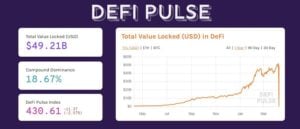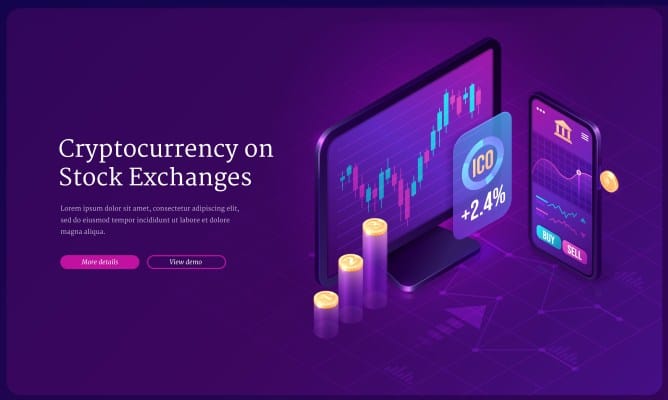Decentralized exchanges, crypto wallets, and peer-to-peer loan platforms are just the tip of an iceberg in the booming market of blockchain apps. Who could have thought that you can run a distributed healthcare or fintech application where both consumers and providers have an equal say in how data gets aggregated and shared? Today, the distributed ledger technology (DLT) makes such a solution a reality.
If you’re looking for tips on how to create a blockchain application and join the decentralized apps (aka dapps) revolution, you’re in the right place. We’ll discuss everything you need to know about building a dapp.
Table of Contents:
- What Are Blockchain Apps?
- Blockchain App Market Overview
- Popular Apps Using Blockchain
- Benefits of Blockchain Apps
- Popular Industries for Blockchain Application Development
- Types of Blockchain Based Application Development
- Top Platforms for Blockchain App Development
- Blockchain Application Development Steps
- How Does a Blockchain Application Work?
- Our Experience Creating Blockchain Apps
What Are Blockchain Apps?
Before we discuss blockchain app development, let’s quickly recap what blockchain (aka DLT) and blockchain apps really are. After all, this technology directly relates to the most fundamental layer of dapp applications.
If we step back a little and think about why we use apps, we’d have to admit that every application stores, processes, and shows us some data. Take the Stocks app on your phone: price charts, industry news, indexes — it’s all data, fetched by the app, processed, and displayed in the most digestible format. Take this data away, and the app becomes an empty shell.

For a regular app (99% of today’s software), data lives on centrally controlled servers owned by a company that built an app. For example, Apple’s Stock app uses the company’s servers that pull info from exchanges and news sites and then serve it to users through the app’s interface. The key here is Apple solely controls how the app’s data is processed and served to customers.
Contrary to that approach, blockchain technology in healthcare has pushed a new type of database to the tech scene — the one without a central authority but with a self-containing security mechanism. It’s a distributed database that:
- exists on many computers simultaneously
- algorithmically verifies new data before it’s added to the database
- protects all data from overwriting, editing, or deleting
- provides full transparency into its state, including all updates

In that sense, any application — whether a mobile or web app — relying on a distributed database is a blockchain app. There you have it! Your blockchain app may look like another web or mobile app to consumers.
However, if it operates off a distributed ledger on the inside, it’s a blockchain app, also referred to as a distributed app or simply dapp. So when you plan to develop a blockchain application, remember that on the outside, to consumers it still looks like a regular application.
In fact, most people half the time can’t tell if they’re using a distirbuted app or a centralized solution that just happens to deal with crypto. That’s why failures like Celsius or FTX could happen in the first place.
Blockchain App Market Overview
To get some understanding of what the blockchain app market looks like, you need to know three simple facts:
- There are different types of blockchains out there to power your dapp
- A blockchain app can run on a permissioned chain (requires access rights) or on a permissionless (publicly accessible) chain
- DLT is still a nascent technology, and you can build a blockchain app of any sort
Chain apps out in the wild
Most people immediately think of Bitcoin when they hear blockchain, but in the context of blockchain application development, Bitcoin is actually useless. This chain is purely for transactions, and you can’t build distributed apps on its protocol.
[Update as of May 2023: I stand corrected. Recently, bitcoin ordinals (NFTs) managed to cause Bitcoin congestion and freightening transaction fees. However this experiment with a new bitcoin protocol BRC-20 goes on to show ineffectiveness of the Bitcoin chain for dapps. So, you definitely don’t want to develop blockchain applications for Bitcoin.]
If your goal is creating a dapp, the most popular choice is Ethereum (smart contract development). This chain supports smart contracts — self-executing algorithms that fire off when preprogrammed conditions are met.
Other blockchain platforms that allow building dapps include EOS, TRON, Steem, and a few others. At the same time, these other chains host considerably fewer blockchain apps compared to Ethereum:

That’s probably because Ethereum nodes became the powerhouse for the second-largest cryptocurrency in the world and because it premiered the core technology for building distributed apps — smart contracts. Therefore, many founder choose to create blockchain applications on Ethereum.
Do you focus on Ethereum development or plan to have a dapp distributed across multiple networks?
Private and public blockchains
Please note that the number of dapps available on Ethereum and other chains we’ve just covered includes only those public distributed apps that work right on blockchains. That means they can be freely accessed by any member of the chain.
There are also many permissioned (aka private) blockchain apps that exist off main chains. Such applications can be used only by authorized users and have broader adoption in the business world. You develop a blockchain app on a private blockchain when you know counterparties joining the protocol and the app’s data needs to be freely shared between and accessible by all network members.
As you can see, public and private blockchains have their own use cases.
Related: How to Create a Private Blockchain on Ethereum.
Types of blockchain apps
As I’ve mentioned above, blockchain apps still remain terra incognita, and, therefore, any idea for a distributed app holds potential. However, if we consider the types of chain apps that have gained the most traction today, we’ll notice lots and lots of finance-related solutions.

These distributed apps go by the name of DeFi — decentralized finances. DeFi solutions include a wide range of financial apps: from crypto loaning applications to decentralized exchanges to crypto wallets to payment tools, to name just a few.
You can also build blockchain apps in other popular categories such as:
- games and gambling
- identity and security management
- insurance
- marketplaces
- decentralized healthcare
- supply chain solutions
However, the financial aspect (aka tokenomics) will remain the driving force of your dapp, regardless of the niche or use cases you pick while developing blockchain applications.
Popular Apps Using Blockchain
To stir your imagination, before describing the process of building apps on blockchain networks, let’s look at some of the popular blockchain-based applications.
Brave — a web browser
Brave is an open-source web browser built on the Chromium engine, aiming to overturn the whole advertising paradigm on the internet. The browser blocks all regular ads on web pages and disables any third-party tracking services, bringing back private browsing to the customer.

Brave uses an internal cryptocurrency to pay users for watching ads separately from their browsing experience and to reward publishers who generate the most user-engaging content.
Binance — a crypto exchange
Binance is a typical case of a DeFi chain-based application. This cryptocurrency exchange allows customers to trade various crypto tokens and earn interest by staking their crypto on the platform.

KYC-Chain — a compliance solution
KYC-Chain helps companies to comply with KYC, AML, and other regulations. Using the KYC-Chain platform, businesses can verify customers’ identities and streamline their KYC onboarding processes when building blockchain apps.

Compound — autonomous interest rate protocol
Compound Finance is another example of a DeFi application for borrowing and lending cryptocurrencies. This decentralized platform uses blockchain to allow customers lend or borrow crypto assets based on real-time supply and demand.

Trust Wallet — crypto wallet
If you plan to create a blockchain app to help users manage their digital funds, it’s worthwhile to check out Trust Wallet. It’s a multi-coin wallet for securely storing and exchanging crypto assets. The product is available for both iOS and Android mobile platforms and supports all Ethereum-based digital tokens. In fact, Trust Wallet is a perfect case of blockchain mobile app development.

As you can see, there’s no shortage of customer and business needs that you can address by creating a blockchain application. Dapps use blockchain for different purposes, but they all rely on these distributed networks as a single source of verifiable digital information.
For a comprehensive guide on digital wallet app development, explore our detailed article that covers everything you need to know.
Benefits of Blockchain Apps
When you plan to create a blockchain-based application, the last thing on your mind is the hype surrounding the technology. You need some tangible value that DLT can bring over to your solution.
Fortunately, you can expect all decentralized blockchain tech’s advantages to carry over into your distributed application. First and foremost, I’m talking about cost reduction, transparency, security, and autonomy.
NB remember that these advantages come at a cost. You will often hear this sentiment, “A blockchain works a world’s slowest database”. Some blockchains have stood up to this challenge, mastering hundreds and even thousands of transactions per second, which also comes at a cost, and we’ll cover that later.
Reduced costs
Blockchain-based applications aim to improve business processes by removing any intermediaries and third parties from workflows. As a result, the cost of performing the same services while using fewer resources goes down.
Transparency
All users of a dapp have complete visibility into what’s happening in the app, and that’s often one of the main reasons to opt for a dapp instead of a traditionally architected application.

Let’s say a clinic and an insurance provider decide that they can significantly streamline their cooperation by getting their internal workflows mutually transparent for each other. The development of a blockchain app can help them achieve this new level of collaboration without creating additional overheads.
However, you should know that even if you build an app on blockchain that’s fully decentralized, that doesn’t mean all its users know how to verify transactions in the dapp. So, a basic UI that simplifies and explains on-chain data can go a long way.
Security
A properly-built dapp is more secure than any regular app by default simply because of the way that blockchain technology functions. Its mechanism prevents data from being erased or tampered with, and any updates to the app require consensus among all application users. In addition, all data is strongly encrypted.
At the same time, building blockchain applications that are trustworthy will require security audits from established vendors.
Autonomy
A DLT application can authorize certain actions on its own by using smart contracts (required to develop blockchain apps). These mini-apps, built into a dapp, trigger when preconfigured conditions are met.
For example, a decentralized app can connect to a service reporting delayed or canceled flights and automatically initiate payouts to affected passengers.
Popular Industries for Blockchain Application Development
Key industries that can benefit by investing in blockchain application development include the following.
Finances
The financial industry has been at the forefront of adopting blockchain technology. Blockchain-based financial applications offer increased security, transparency, and efficiency in various areas such as cross-border payments, remittances, asset management, and decentralized lending.
Example: Ripple (XRP) utilizes blockchain technology to enable faster and cheaper cross-border transactions, reducing the need for intermediaries like banks.
Insurance
Insurance companies can leverage blockchain to streamline processes such as claims management, policy administration, and fraud detection. By storing policy details, claim records, and other relevant information on a blockchain, insurers can enhance transparency, reduce fraud, and improve the efficiency of claim settlements.
Example: Insurwave, a collaboration between insurance companies and technology providers, uses blockchain to manage marine insurance policies, providing real-time data and automating manual processes.
Healthcare
Dapps have the potential to revolutionize the healthcare sector by securely storing and sharing sensitive patient data, improving interoperability, and enabling efficient supply chain management.
Example: Healthereum, for instance, utilizes blockchain to incentivize patient engagement, allowing healthcare providers to reward patients for completing specific tasks, such as medication adherence or post-treatment surveys.
Real estate
Blockchain technology can bring transparency, trust, and efficiency to real estate transactions, including property ownership, title transfers, and smart contracts for rentals or property sales.
Example: Propy is a blockchain-based platform that enables users to buy and sell properties globally, offering a secure and transparent environment for property transactions, reducing fraud, and eliminating the need for intermediaries.
Retail
Blockchain applications can enhance supply chain management, product authentication, and loyalty programs in the retail industry. By recording the entire product journey on a blockchain, retailers can verify the authenticity and provenance of goods, reducing the risk of counterfeits.
Example: Walmart, in partnership with IBM, has implemented a blockchain-based system to track the movement of food products from farm to store, enabling faster recalls and ensuring food safety.
Travel
Blockchain can simplify travel and tourism by providing secure digital identities, efficient booking systems, and transparent reviews. With blockchain, travelers can have control over their personal information while securely sharing it with airlines, hotels, and other travel service providers.
Example: Winding Tree is a blockchain-based travel platform that connects customers directly with suppliers, eliminating the need for intermediaries and reducing costs.
Financial decentralized apps (dApps) are particularly common within the blockchain space due to the potential for price speculation and trading opportunities. Platforms like Ethereum have facilitated the development of various decentralized finance (DeFi) applications, such as decentralized exchanges (DEXs), lending platforms, and yield farming protocols. These dApps enable users to participate in financial activities, such as earning interest on their digital assets or providing liquidity to decentralized markets, without relying on traditional financial intermediaries.
Types of Blockchain Based Application Development
Depending on your goals with a dapp, you can build different types of dapps using permissionless or permissioned blockchain architecture.

Public
Public (aka permissionless) decentralized apps are open to all members of the mainnet (e.g., Ethereum) that you choose for deploying your dapp. Clearly, that approach is often preferred for DeFi solutions and crypto games when blockchain app developers want to attract as large an audience as possible.
Read also How to Create a DeFi Staking Platform.
Private
Private (aka permissioned) dapps can be used only by authorized users. Transparency, data integrity, and all other DLT characteristics still have an effect in such decentralized apps, but only for authorized users.
Consortium
Consortium blockchain apps belong to private dapps. The difference is consortium dapps are developed by a group of companies who jointly control how the application functions and who can work with it. At the moment, consortium block chain app development is not widely popular.
Creating blockchain applications on public networks like Ethereum (layer 1 network) or Arbitrum (layer 2 network, working on top of Ethereum) is a popular choice.
Top Platforms for Blockchain App Development
As already mentioned, Ethereum is the number one choice for many dapp developers. And it certainly would have been your first choice up until recently, were you create a financial decentralized app.
However, as of May 2023, we’re still in the bear market, and the exuberant transaction fees are already scaring people away from using decentralized software deployed on Ethereum. When it costs $50 to merely swap a coin or send somebody a payment and bull-run profits are still far away, only few customers decide to part with hard-earned dollars. The high-end fees are reaching $700-$1,000 range and beyond.
So what else is there beyond Ethereum? If we check the top 25 dapps on sites like DappRadar and note the chains where these apps are hosted, we’ll get the following list of most popular blockchain platforms, besides Ethereum:
- BNB (former Binance Smart Chain)
- Polygon
- Optimism
- WAX
- Arbitrum
- Avalanche
- Fantom
- EOS
A few others also include Solana, Near, Cronos, Moonriver, Cell, and Aurora. How do you pick one?
Let’s get back to why Ethereum would be a natural choice. User adoption – nothing else. You need customers to use your app, and Ethereum has most active users (until the fees started thinning out the market).
The second contender after Ethereum by user count would be BNB: 15 out of the top 25 dapps we reviewed have been deployed there. Compare that with 12 for Ethereum itself (still has more active users than BNB), 7 for Polygon and Optimism, 5 for WAX/Arbitrum/Avalanche, and 3 for EOS and Fantom, with the rest scoring below that.
So, if not Ethereum then BNB. However, you might want to take into account other parameters as well. Sometimes your app would work in combination with other existing solutions that may be only availabe on certain networks.
Some readers might ask, “How about super-speedy networks like Solana, processing thousands of transactions per second vs. 12 transactions on Ethereum?” And the answer is, “Who cares if the network is half the time down, got lots of bad PR for stolen funds, is not really decentralized that much, and most importantly doesn’t have that many active users?”
Remember, you want to be reaching millions of users, not thousands (Solana currently has around 600K active daily users).
Blockchain Application Development Steps
How do you approach a blockchain-based application development project? How do you create a dapp that holds true to its promise and really disrupts a niche with its shared economy without app development costs going through the roof? Here are a few things to consider as you start a blockchain app.
Step 1: Define the purpose
First of all, you need to decide who will use your app and how they will benefit from working specifically with a decentralized application. Based on this decision, you will build a private or public decentralized solution, limiting or providing public access to the app accordingly.
Development of a dapp makes perfect sense when:
- you need to create an economically fair environment for all involved parties
- you want to avoid having a central authority police the app’s functionality
- you strive to have complete transparency into all data modifications in the app
- you plan to automate processes that can be simply translated into algorithms
Your decision about the CeFi vs. DeFi nature of a dapp, while making a blockchain app, will affect the tech stack and blockchain software development process.
Step 2: Verify your idea with a prototype
Remember that your dapp should feature a modern user interface to successfully solve the user’s pain points – it’s time to design a blockchain application. To this effect, a dapp competes with every other centrally controlled app that helps customers address the same issues.
Therefore, a blockchain app should first be prototyped as a clickable shell of an application and tested with real users. That way, you check whether users are likely to engage with it once the app is released out in the wild.
Whether it’s going to be a mobile or a web solution, rapid prototyping will help you verify your idea with customers without spending money on coding — the most expensive part of the app development process. In this respect, developing apps for blockchain is no different from web2 app development.
Step 3: Create the user-facing part of a distributed application
Once you’re done verifying the prototypes with users, it’s time to put flesh on the front end of your dapp responsible for the user experience. As we’ve discussed, your solution can be a mobile or web solution, and you should choose the tech stack accordingly to build it.
We recommend picking a modern tech stack that will simplify further maintenance and support of your product. For a web-based solution, it safe to pick from these:
- React/Vue, Express.js, and Node.js with MongoDB or good old MySQL
- Sames as above, except Angular is used for building the customer-facing part
If you’re also branching out into mobile, we advise the following technologies:
- Swift for developing an iOS app
- Kotlin or Java for creating an Android app
- Pick React Native if you need to cover both mobile platforms
Writing a blockchain application specification that covers target operating system and other tech aspects of the product will help too.
Step 4: Build the backbone of your dapp
I bet you know that every app consists of more than a consumer-facing front-end part and also leans on a back end — databases, servers, business logic, well, everything that keeps the front end running.
Dapps are no different in that respect, except they tend to have two back ends. One back end is blockchain-based, consisting mainly of smart contracts. And the other one is similar to back ends you find in regular apps — a web server exchanging and processing data.

Step 5: Know your toolset
When you hire a blockchain app developer, make sure they are familiar with the following technologies. Please note that it’s extremely rare (and costly) to find a developer who knows and has hands-on experience developing apps with blockchain technologies. Here are a few web2 and web3 development tools, programming languages, and blockchain development platforms worth exploring:
JavaScript (React/Vue)
- front-end development
- smart contracts testing
Python, Go, Rust, C++
- back-end coding
- business logic development
Node.js, Solidity
- smart contract development
Truffle
- developing smart contracts with the Solidity programming language
- testing blockchain code
MetaMask
- Ethereum wallet
- provides chain connectivity inside a browser
Ganache
- spin up a local blockchain in seconds with funded accounts
- cheap alternative to setting up a full-fledged testing environment
Web3.js or Ether.js
- connects the front-end portion of a dapp with a blockchain
Express.js
- off-chain back-end development
Remix
- browser-based development environment for writing blockchain code
Note that you will need front-end and server-side developers for building applications with blockchain. Therefore, it’s recommended to partner with a development company experienced in both web2 and web3 technologies.
Step 6: Testing decentralized apps
After building a blockchain app, you need to thoroughly check it for any discrepancies and bugs. Especially if it’s a public dapp deployed to a mainnet because there’s no easy way to fix it once you deploy it.

Remember that testing a dapp should include both UX testing of interfaces and integration testing that uncovers any issues in how your app connects with third-party solutions.
In an ideal scenario, you release a copy of your decentralized app to Blockchain Testnet and have real users go through the main steps of using the software while you catch all lingering bugs.
Related: Mobile App Usability Testing
Step 7: Launching a dapp
When you’re launching a dapp, you are effectively releasing several applications:
- deploying consumer-facing mobile apps to the App Store and Google Play
- setting up a consumer web application on a cloud service, such as AWS
- deploying blockchain code to the mainnet
This release approach guarantees you’ll be able to update different parts of your dapp as you see fit in the future.
The final step before launching your project into the digital finance stratosphere is crucial. When it’s time to deploy a DeFi app, ensure you’re equipped with the best practices and strategic insights that can only be found in our comprehensive development guide.
Hopefully, these 7 steps have shed some light for you on how to make a blockchain application.
How Does a Blockchain Application Work?
You should already have a pretty solid understanding of how decentralized applications function from what we’ve already discussed. But if you’re still struggling to grasp this concept, let’s break it down in simple terms whether you’re building a fintech app or a healthcare app.
Customer applications
When you’re building an app on blockchain technology, it doesn’t mean your customers will need to interact with something unfamiliar or overwhelming. On the surface, people will continue using software featuring (hopefully) friendly and straightforward user interfaces.
Your solution can be:
- a mobile application
- a web portal
- or even a mixture of both
In fact, it can be as comfy as Gmail if Google one day decided it would be a great idea to make emailing completely public and transferred Gmail’s back end to a blockchain network.
Core blockchain platform
At the same time, the core blockchain component of your decentralized application, hidden behind the glossy user interfaces, remains responsible for executing, verifying, and logging all transactions happening in the application.
It doesn’t matter whether the product is built on a private, public, or consortium distributed ledger. What matters is all users of the dapp have equal access and visibility into all operations happening in the solution. That’s where you’ll keep:
- blockchain code
- smart contracts
APIs
APIs are sort of links connecting your front end applications with the core decentralized component of your dapp. Besides that, an API can provide connectivity between your decentralized application and other third-party platforms.
An easy way to think about APIs in the context of blockchain app development is to imagine a set of rules, explained via code, describing how a blockchain solution can exchange data with other systems. In a nutshell, a development team can’t write a blockchain app without working at least with one API these days.
How to Integrate a Blockchain App With Your Business
So if you’re launching a dapp that becomes an extension of your business, you need to consider how it will integrate with the rest of your systems. And APIs that we just covered is exactly the answer you’re looking for.
The most straightforward use case is to start accepting crypto payments. Pick a payment provider that offers this option and offers APIs for customization and voilà – you now accept USDC, BTC, and ETH. By the way, Stripe has recently added crypto as well.
Our Experience Creating Blockchain Apps
At Topflight, we’re developing a cryptocurrency app in the DeFi space that will compete with solutions like Celsius or Gemini, where users will be able to easily buy crypto with a credit card.
We’re also working on launching a decentralized auctioning platform that will work as a hub for small businesses to team up and consolidate their supply purchasing power to compete with large chains like Krogers.
You may want to check out this case study to learn how we created a DEX and NFT marketplace to accompany a metaverse game.
Reach out today if you’re planning a decentralized marketplace, healthcare, or fintech application. Let’s talk dapp development!
Related Articles:
- Guide to Creating a Payment Gateway for Cryptocurrency
- How to Create a Cryptocurrency Token
- How to Start a Decentralized Autonomous Organization: Complete Guide on DAO
- How to Create a Crypto Wallet
- Building a Cryptocurrency Bot
- Guide to Developing a Crypto Trading App
- How to Create a Cryptocurrency Exchange
Frequently Asked Questions
How long does it take to make a blockchain app?
Depending on the complexity of the solution, between 3-4 months.
How much does it cost to build a blockchain application?
An MVP will often fit within the $80,000 budget, whereas you can expect to cash out around twice as much for a full-fledged distributed application.
Should I build a dapp on a private or public chain?
If you’re targeting the general public, use a public blockchain. If you’re not ready to share the app’s data with everybody on the internet, revert to a private decentralized solution.
What are the must-have blockchain development tools?
Solidity, Truffle, Ganache, and Blockchain Testnet. Make sure your blockchain app developer is well versed in this tech stack.
How do I connect my blockchain app to external data sources?
For these purposes, you should use oracles.
When I create an application using blockchain, will its data reside in secure cloud storage?
You may pick various architectures, including those where some of the application’s data is kept in a cloud service. However, the transactional data should remain on the blockchain itself. In this case, it’s not in cloud storage but in a peer-to-peer blockchain network. This transactional data will exist on every device that’s connected to the chain.
Can I create an application on blockchain that is purely mobile?
You can’t avoid developing the back end (aka server-side) of your dapp simply because mobile devices do not have enough capacity for prolonged connectivity on the network: not enough storage and relatively short battery life.

